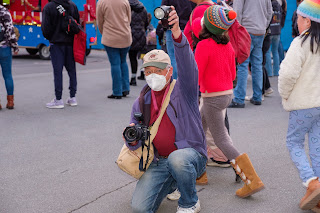 |
| Shot with Voigtlander Snapshot Skopar on a Sony A7 body. |
I have a habit of saying, "Never handle anything that you are not prepared to own". Once in a while, a piece of equipment will fall into your hands and you'll experience an instant rapport. You will find your perfect muse, the medium through which you convert a momentary visual experience into something tangible and permanent, be it printed or published.
 |
Snapshot Color Skopar. Image Source: Click here.
Note the rangefinder cam. |
Shawn, my friend and Leica uber-enthusiast, is a careful photographer, His collection of lenses (all mint, I might add) includes some Voigtlander primes for his M-Series bodies. I became more interested in the compact Leica lenses since converting to Fuji mirrorless cameras. The Fuji X-Pro1 was a digital homage to the Leica M3, as the former went to great lengths to simulate the style and feel of the latter. In addition, the mirrorless designed allowed a wide variety of lenses to be attached, breathing new life into those film era lenses sequestered in boxes and drawers, anxiously waiting for their chance to be used once again. Alas, the APS sensor cropping of the Fuji bodies denied my vintage wide angle lenses their true aspirations of recording sweeping vistas and unusual compositions.The full-framed Sony A7 changed all that. Introduced in 2013, they are now reasonably priced on the used market, so I purchased a near-mint specimen and some lens adapters (Nikon, Pentax Thread, Minolta) to go with it. The body was also shallow enough to accept vintage rangefinder lens, should I encounter one. I looked down upon my newly acquired kit and I saw that it was good.
Troublemaker: Shawn, on hearing about my Sony, loaned me three Voigtlander M mount lenses to try, including the Snapshot Skopar I had shown an interest in. Since the proper adapters were relatively inexpensive, it was a chance to experience these elegant older lenses using digital capture technologies. I wound up purchasing both the earlier threaded adapter (L39) and and bayonet M adapter. I had some difficulty mounting the lenses, as the fit was very tight. For fear of damaging the mount, I seated the lens only finger tight and cradled the lens in my hand while I used it. I stepped outside and made a few exposures, and returned to my laptop to see what the little lens hath wrought.
 |
| Original File: Color Preset Vivid , Exposure Compensation +0.3. |
This sample file was something of an eye-opener. The image was exposed using Aperture Priority, and the histogram shows that the Sony's metering was spot-on. The EXIF data indicated that I had an Exposure Compensation setting of + 1/3 stop, an anomaly, since I normally set it to - 1/3 to get a more pleasing (to me) rendition of the sky. I was not prepared for what I saw when I enlarged the file. There was a much wider variety of shades of green in the foliage, and an "snap" to the image that I hadn't seen before. The lens was incredibly compact, as one would expect from a rangefinder-dedicated lens design. And the undeniable quality of the construction whispered volumes. I was entranced.
Leica Or Leica? According to Shawn, the lens came in two variants. The first was designed for the pre-M series Leica bodies that used the screw thread mount, while later improved versions, identified as the "Color" Skopars, had bayonet mounts for the M-Series Leicas, and rangefinder coupling for precise focusing. In addition, an accessory viewfinder was available for use on the original Leica III and M series cameras.
I found this ad for a threaded non-color Snapshot Skopar at KEH Camera. Since I would be using it with a mirrorless camera body (either Sony A7 or Fuji X), the absence of a viewfinder wasn't a problem. The threaded mount wouldn't be an issue with either system, since the necessary adapter would always stay mounted on the lens. The price was close enough to the newly-manufactured Chinese lenses that are being offered in rangefinder-coupled Leica M bayonet mounts. So after several days of pre-purchase anguish, I bought it.
I can only hope that the little lens will perform as well as Shawn's Color Skopar, but it if just comes close I'll be very happy. After all, I've been using bargain-basement manually focused Chinese lenses, and I've been pleased with their performance so far. I will keep you posted.

















































